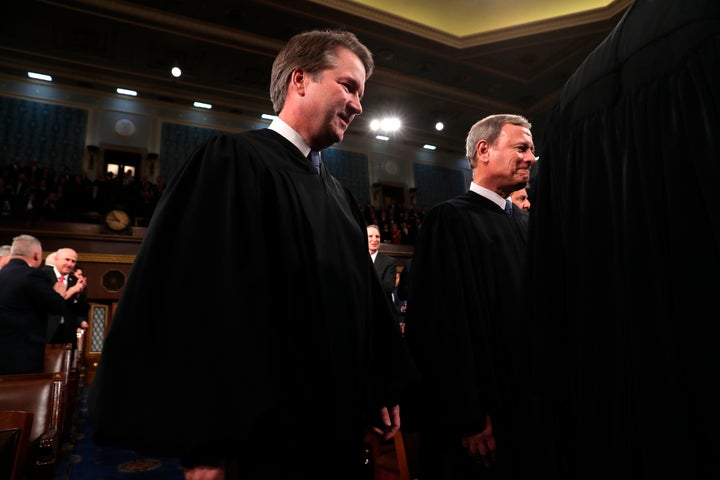The Supreme Court’s six-vote supermajority greatly expanded gun rights in its decision striking down a law in New York state limiting who can receive a permit to carry a concealed firearm in public on Thursday.
The decision, written by Justice Clarence Thomas and joined by the other five conservative justices, found laws like New York’s 100-year-old concealed carry law requiring people to show proof of the need of a firearm for self-defense unconstitutional. Thomas’ decision also limits the manner in which courts may determine whether a gun control law is constitutional solely if “the regulation is consistent with this Nation’s historical tradition of firearm regulation.”
But Justice Brett Kavanaugh also wrote a concurrence, joined by Chief Justice John Roberts, that appears to suggest some limits on the majority opinion.
Kavanaugh and Thomas wrote “separately to underscore two important points about the limits of the Court’s decision,” according to the concurrence.
The first limit on the decision is that the ruling striking down New York state’s concealed carry permitting law only applies to the six other states with similar “may issue” laws.
“[T]he Court’s decision does not prohibit States from imposing licensing requirements for carrying a handgun for self-defense,” Kavanaugh writes.
What the decision does not prohibit, according to Kavanaugh, are “shall issue” laws that only require a background check or firearms safety training to obtain a concealed carry permit rather than New York’s far more restrictive permitting law.
This is fairly similar to the language in Thomas’ majority opinion. The main difference is that Thomas includes in a footnote the possibility of striking down elements of “shall issue” laws if they have provisions that are “put towards abusive ends.”
“[B]ecause any permitting scheme can be put toward abusive ends, we do not rule out constitutional challenges to shall-issue regimes where, for example, lengthy wait times in processing license applications or exorbitant fees deny ordinary citizens their right to public carry,” the footnote states.

Kavanaugh’s concurrence is more firm in its assertion that “shall issue” states are on sound constitutional ground.
The second limit in Kavanaugh’s concurrence is a reiteration of the statement in the 2008 decision in Heller v. District of Columbia, which found an individual right to bear arms in the Constitution’s Second Amendment, that the decision was “neither a regulatory straightjacket nor a regulatory blank check.” States and the federal government could still adopt some restrictions on firearms.
Kavanaugh includes a large block quote from the Heller decision to underscore that the majority decision had not stripped the ability of the government to regulate guns in every manner. Those regulations mentioned as permissible include “possession of firearms by felons and the mentally ill, or laws forbidding the carrying of firearms in sensitive places such as schools and government buildings, or laws imposing conditions and qualifications on the commercial sale of arms.” But that list is not “exhaustive,” meaning others could exist.
The majority opinion remains the controlling opinion in this case. That means that its findings are now the law. But the concurrence could still influence lower courts since it bears the hallmarks of a “pivotal concurrence.”
A pivotal concurrence is “when there is a majority opinion, one or more judges concur in the majority opinion but also writes separately, and that judge’s vote is numerically necessary to give the majority opinion enough votes to become binding precedent,” according to a law review paper by lawyers Thomas Bennett, Barry Friedman, Andrew Martin and Susan Navarro Smelcer.
“The opinion is ‘pivotal’ in the sense that without the votes of the pivotally concurring Justices, there would be no majority opinion,” the paper continues.
Kavanaugh’s concurrence meets these criteria and that’s what makes it notable.
“If you look forward to the next case — the one about some other state’s gun licensing regime — then you have to worry about whether you can count on the votes of Kavanaugh and Roberts,” Bennett, one of the authors of the paper, said. “And if that’s your point of view, then you have to pay really close attention to what they say in their concurrence.”
Since there is no sense of why Kavanaugh and Roberts felt the need to lay down these markers, it is not clear how this could alter future outcomes.
Was this to indicate that Kavanaugh and Roberts would not go as far as the other four conservative justices want to? Was it a public relations decision to make the majority decision less distasteful to a public that supports further gun control than currently exists? Or something else?
Either way, Harvard Law professor Noah Feldman said in a Bloomberg column, “Kavanaugh’s insistence that some gun regulation remains permissible tells you a lot about how far Thomas’s opinion went.”
Thomas’ limitation of all future court review of gun laws to historical analogues threatens to upend so many existing gun laws and those currently debated in Congress that lack historical analogues, like red flag laws and bans on gun ownership for domestic abusers.
“It’s true that’s going to be a major issue of uncertainty going forward,” Bennett said. “Exactly how this historical methodology that the majority sets out matters for the panoply of gun regulations in all 50 states. The tension will be the one between the majority and the Kavanaugh and Roberts view.”

